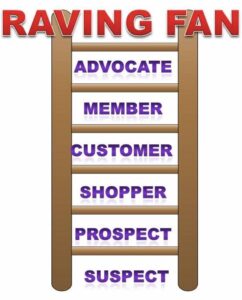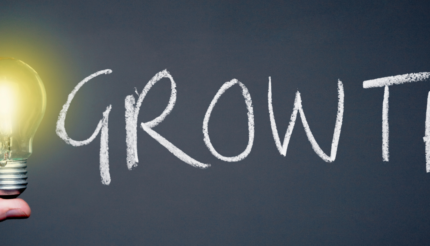The Ladder of Loyalty
A Seven Step Process For Creating Raving Fans

As a business proprietor in the UK, one often dreams of cultivating a fervent following of customers who ardently advocate for their brand. The aspiration is for clients to not merely recommend, but to effusively praise the business. These are the patrons who wholly believe in your brand and ceaselessly share their positive experiences with others.
But what’s the secret to fostering a robust, devoted customer base?
To develop a loyal customer community, it begins with the initial interaction. If you can wow your customers on their first interaction with you then you can get them climbing the ladder quickly.
The ‘Ladder of Loyalty’ represents a seven-stage journey towards cultivating raving fans. To elevate more customers to this pinnacle, it’s crucial to systematically enhance each stage, always keeping the ultimate goal in sight.
What Exactly is the Ladder of Loyalty?
This concept is a guide for businesses to understand and cultivate loyal customer relationships.
It suggests that customer loyalty evolves through stages – from awareness to engagement, conversion, advocacy, and beyond. This ladder serves as a blueprint for marketing strategies and customer service approaches, helping businesses to pinpoint their customers’ current loyalty stage and strategise ways to advance them further.
By grasping the Ladder of Loyalty, businesses can devise strategies to nurture client relationships, thus expanding their loyal customer base in a mutually beneficial manner.
As customers climb the ladder, trust increases, speed to purchase increases, profit increases and customer loyalty increases. Ultimately new leads will increase too as your clients start to advocate and rave about your business.
Why is a Customer Loyalty Ladder Crucial?
The ladder is vital for businesses aiming to boost repeat sales. It offers insights into the customer journey and the significance of repeat business – focusing on ‘wallet share’ rather than ‘market share’.
New lead generation can be costly, whereas existing customers, already familiar and trusting of your company, are more economical for upselling, cross-selling, or generating referrals. Retaining current customers for ongoing business and referrals is one of the most profitable growth strategies. Plus, satisfied customers tend to refer equally valuable new customers, making it a rewarding growth method.
The Seven Stages of the Customer Loyalty Ladder

- **Suspect**: Potential clients who fit your target market but are not yet aware of your business. Initial marketing efforts are crucial at this stage.
- **Prospect**: Individuals who have shown interest in your product or service, potentially leading to a purchase.
- **Shopper**: First-time buyers whose loyalty is not yet secured.
- **Customer**: Repeat clients who are crucial for sustained business growth.
- **Member**: Clients who feel a sense of belonging and exclusivity with your brand.
- **Advocate**: Customers who recommend your business when prompted.
- **Raving Fan**: The ultimate loyal customers who spontaneously and frequently promote your brand.
Strategies for Elevating Clients on the Loyalty Ladder
Consider the following:
- Identify current Raving Fans and understand their motivations.
- Assess which stages of the ladder need more focus.
- Enhance first interactions to encourage early referrals.
- Devise strategies for encouraging repeat purchases.
- Learn from past clients who ceased business with you.
- Show greater appreciation to loyal customers.
- Convert repeat customers into referrers.
The 80/20 rule applies here: the majority of your profit comes from a small fraction of your customer base. Hence, focusing on repeat customers and referrals is not only profitable but also enjoyable.
Look at each customer and decide where they are on the ladder. How many customers do you have in each area? What are your strategies going to be to move them up the ladder?
The Impact of the Customer Loyalty Ladder
By monitoring customer loyalty levels, you gain insights into customer engagement with your brand and the most effective strategies for attracting and developing new customers into key marketing assets.
This also allows for identifying areas of improvement to better serve customers and build loyalty.
Keep in mind that customers might not follow this ladder linearly. They may skip stages or oscillate between them, so flexibility, ongoing feedback, and strategy adjustments are important.
FAQs
**Origin of the Ladder of Loyalty**: Brad Sugars, a renowned author and founder of ActionCOACH, conceptualised this model to help businesses gauge customer loyalty and engagement.
**Measuring Loyalty**: Typically through repeat business and customer referrals, but other methods like NPS surveys and lifetime customer value are also relevant.
**Building Loyalty**: It’s about delivering exceptional experiences, meeting needs, offering value, and expressing appreciation, thereby fostering trust and long-term relationships.



